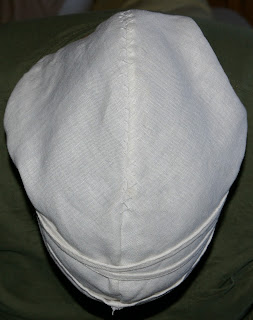 The Maciejowski Bible (also know as The Morgan Bible of(PML M.638), c. 1250 By Engelinne VonFoxridge
The Maciejowski Bible (also know as The Morgan Bible of(PML M.638), c. 1250 By Engelinne VonFoxridgeName of piece and what layer it represents:
This piece is called a hat and it represents the accessory layer.
Period and origin of time:
The period of origin I am using is the 1300’s my persona is of Austrian decent so I am using Austria as the place.

Linen was used in period.
Material I used:
I used linen.
How I assembled the pieces:
I cut out a piece that was roughly the shape of my head. I sewed them together tried them on and re-shaped them to fit my head. Then I cartridge pleated the bottom by the neck. I made strings by folding long strips of linen and sewing them. I used the herringbone stitch up the center seam of the hat. Lastly I added them to the back of the hat.
What I did and the difference between:
The difference is that I used cotton string instead of linen.
History:
The earliest head coverings were probably made of animal skins and were designed to protect the wearer from the weather. Headdress also helped women with the control of their hair. Through the years, head covers evolved to reflect the status and culture of the wearer. The hat moved from status to part of a uniform and to an art form. As the social order became more and more defined, so too did the variety and importance of headwear. During the Middle Ages, women wore simple coifs, wimples, and veils. In fashion terms, hats are a very noticeable accessory because the onlooker’s attentions is first drawn to the face. Headwear of the Middle Ages was not an accessory, per say, but instead a part of the outfit.
 The cap of Saint Birgitte in the Birgittine Convent in Uden, photo's by Isis Sturtewagen
The cap of Saint Birgitte in the Birgittine Convent in Uden, photo's by Isis Sturtewagen.This small white linen coif is attributed to St. Birgitta of Sweden. It was housed at the Birgittine convent of Marienforst near Bonn, and more recently owned by the Birgittine convent of Maria Refugie in Holland.
What I learned:
I learned about St. Birgitta coif.
Houston, Mary G. Medieval Costume in England and France � The 13th, 14th, and 15th Centuries, Dover 1996.
Norris, Herbert. Medieval Costume and Fashion, Dover 1999.
Braun & Schneider. Historic Costume in Pictures, Dover 1975.













No comments:
Post a Comment